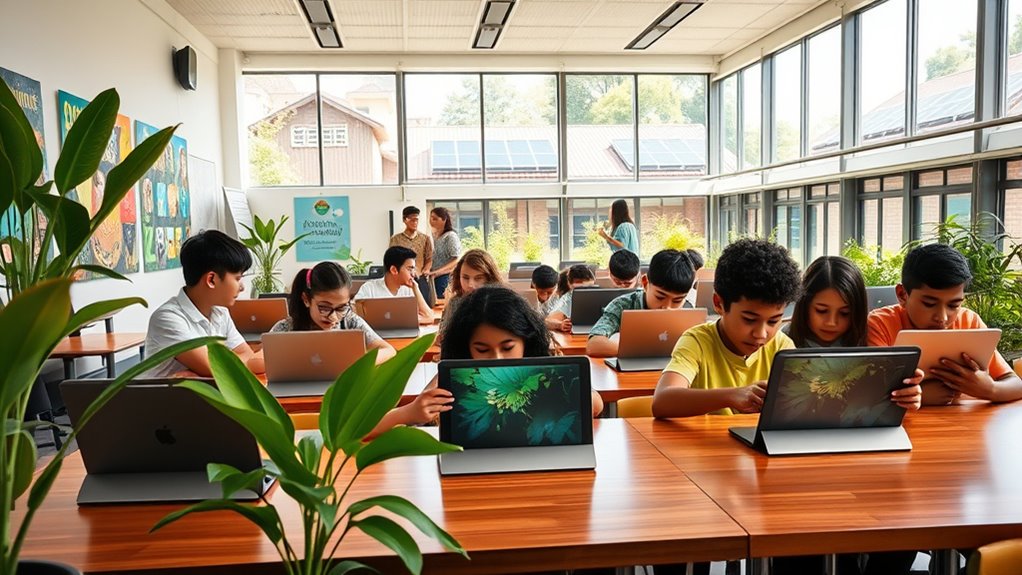Adopting digital textbooks helps you reduce paper use, conserve forests, and lower waste, making education more sustainable. Green school infrastructure with solar panels and energy-efficient designs further cuts energy consumption and promotes eco-friendly habits. By integrating renewable resources into curricula and encouraging student projects, you foster awareness and responsible behaviors. These practices not only lessen environmental impact but also inspire broader change. Keep exploring to discover more ways you can create a greener, more sustainable learning environment.
Key Takeaways
- Digital textbooks reduce paper use, lowering environmental impact from production, shipping, and disposal.
- Green school infrastructure utilizes renewable energy and eco-friendly materials to minimize operational carbon footprint.
- Incorporating renewable resources into curricula promotes student awareness and engagement in sustainability practices.
- Energy-efficient school designs, like natural lighting and rainwater harvesting, enhance sustainability and reduce costs.
- Schools modeled as eco-friendly institutions inspire broader community adoption of sustainable development initiatives.

How can educational technology promote a more sustainable future? The answer lies in how you integrate digital tools and innovative approaches into learning environments. By adopting digital textbooks instead of traditional paper ones, you reduce the demand for paper, which often relies on non-renewable resources like fossil fuels and other environmentally taxing processes. Digital textbooks require less physical material and energy to produce, ship, and dispose of, making them a more eco-friendly choice. When you leverage these resources, you’re actively decreasing the carbon footprint associated with textbook manufacturing and waste. Additionally, incorporating eco-friendly infrastructure into schools can further enhance sustainability. Green buildings designed with renewable resources such as solar panels, wind turbines, and energy-efficient systems not only cut down on energy consumption but also serve as living examples for students about sustainable practices. These eco-friendly infrastructures create healthier learning environments, foster environmental consciousness, and demonstrate that sustainability isn’t just a concept but a practical approach. Promoting energy-efficient designs in school architecture is essential to maximizing these benefits and minimizing environmental impact. You can also empower students to understand the importance of renewable resources by integrating them into curriculum projects and school operations. For example, using solar-powered devices or promoting energy conservation initiatives helps students see firsthand how renewable resources can replace finite, polluting options. As you encourage the use of digital textbooks, you also promote a shift toward less paper dependence, which supports forest conservation and reduces waste. This shift aligns with the broader goal of fostering a culture of sustainability where resource efficiency becomes second nature. Schools built with eco-friendly infrastructure serve as models within communities, inspiring other institutions to adopt greener practices. These buildings often incorporate natural lighting, rainwater harvesting, and sustainable materials, reducing energy consumption and environmental impact.
Frequently Asked Questions
How Do Digital Textbooks Impact Student Engagement Compared to Paper Books?
Digital textbooks boost your student engagement more than paper books by offering interactive learning features that make lessons more dynamic. These tools enhance student motivation, encouraging active participation and curiosity. You can easily access multimedia content, quizzes, and annotations, making studying more personalized and enjoyable. As a result, you’re more likely to stay focused and retain information, turning learning into an engaging experience rather than a passive task.
What Are the Challenges of Implementing Green Practices in Edtech Infrastructure?
Like planting a seed in rocky soil, implementing green practices in EdTech infrastructure faces hurdles. You encounter costly infrastructure that strains budgets and slows progress. Technology adoption can feel like climbing a steep hill, as resistance from staff or lack of training hampers change. Balancing environmental goals with financial realities requires patience and innovation, but with perseverance, you can nurture a greener, more sustainable educational future that benefits everyone.
How Can Schools Measure the Environmental Benefits of Digital Textbooks?
You can measure the environmental benefits of digital textbooks by conducting a lifecycle assessment, which evaluates their entire environmental impact from creation to disposal. Track reductions in the carbon footprint compared to traditional textbooks, considering factors like manufacturing, transportation, and disposal. Regularly analyzing these metrics helps you quantify sustainability gains, ensuring your school’s digital initiatives genuinely contribute to environmental conservation and support green practices effectively.
Are There Any Privacy Concerns With Digital Textbook Usage Data?
Yes, there are privacy concerns with digital textbook usage data. You need to guarantee student privacy by protecting data security, so sensitive information isn’t exposed or misused. Schools should implement strong encryption and access controls to safeguard student privacy, and be transparent about how data is collected, stored, and used. Regular audits and clear policies help maintain trust and prevent potential privacy breaches.
How Does Edtech Contribute to Reducing Overall School Carbon Footprints?
Think of EdTech as a beacon guiding schools toward a greener future. You can reduce their carbon footprints by promoting energy conservation through smart devices and digital platforms. Digital textbooks cut down paper waste, fostering waste reduction. By integrating these tools, you help schools slash energy use and waste, making sustainability a tangible reality. This approach not only saves resources but also empowers students and staff to champion eco-friendly habits.
Conclusion
By embracing digital textbooks and green school initiatives, you can markedly reduce environmental impact. Did you know that switching to digital resources can save up to 2 billion pounds of paper annually? As you support sustainable EdTech practices, you’re helping to lower carbon footprints and conserve resources. Together, these efforts create a more eco-friendly future for education—where innovation and sustainability go hand in hand. Your choices today shape a greener, smarter tomorrow.









